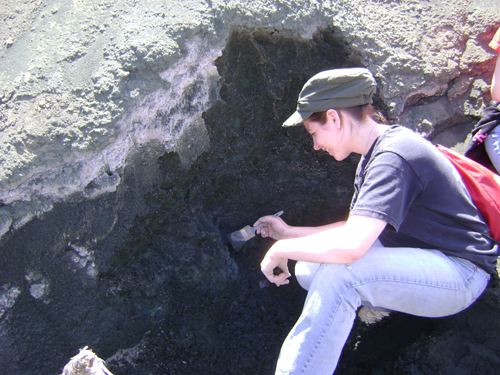Saturday, Jan 1, 2011
Each fall and spring, Dr. William Gallagher runs trips to a marl pit in South Jersey, where his students can uncover fossils of prehistoric creatures.
by Meaghan Haugh
Whether he was in an exhibit memorizing names of dinosaurs or in the field excavating fossils, Dr. William Gallagher has long been captivated by the Mesozoic-Era creatures that once roamed the earth and the theory of what led to the dinosaurs’ sudden demise 65 million years ago. Throughout his career, Gallagher, a native of Philadelphia, has received numerous invitations to participate in digs across the United States and around the world, but he never wandered too far from home to conduct his own research.
“New Jersey actually has a good geological record of that era,” said Gallagher, referring to the Mesozoic Era, a period lasting from 250 million years ago to about 65 million years ago, when dinosaurs, mammals and flowering plants flourished. The era ended with the mass extinction of dinosaurs and other prehistoric creatures.
Now, as an adjunct associate professor in the Department of Geological, Environmental and Marine Sciences, Gallagher introduces his students to the planet’s rich history through inquiry-based education right in their own backyard.
Each fall and spring, Gallagher runs trips to a marl pit in Gloucester County, N.J., for his sections of the courses Marine Life Through Time (MAR-210) and Mesozoic Ruling Reptiles: Dinosaurs, Pterosaurs, and Plesiosaurs (GEO-168). Students have the option of going to the Academy of Natural Sciences in Philadelphia, rather than the marl pit. Gallagher also runs an additional trip to a fossil-rich stream bed in Monmouth County for his Marine Life Through Time section.
As part of the field assignment, students are asked to examine the layers of rock and interpret the changes of the fossils that they collect from each of the layers. Fossils include shark teeth, bits and pieces of turtle, crocodile, fish bones, snails, clams and sponges. Not only do the students discover the fossils they have learned about throughout the course, but they also apply the skills, such as generating hypotheses and gathering data, that they have acquired. With shovels in their hands, students spend four hours digging in the pit and generating hypotheses about the changes in the prehistoric organisms that they have collected.
“You can see students in the pit getting more excited,” Gallagher said. “It takes a little bit to get used to the eye to uncover fossils, but by the end of the trip, it’s not unusual to find things.”
Last April during the Mesozoic Ruling Reptiles course’s trip, Stephanie Pypniowski ’10 excavated the bottom plate of a turtle shell, which was later sent to the New Jersey State Museum.
Another student, Carl Natter ’09, not only gained experience conducting fieldwork, but was also inspired to write his senior thesis about the chemical sediment in the marl pit after taking two trips to the location as both a student in Mesozoic Ruling Reptiles and Marine Life Through Time.
Since he retired from his post as assistant curator of Natural History, Collections and Exhibits at the New Jersey State Museum’s Natural History Bureau in 2008, Gallagher has continued to conduct research in the field.
A few years ago, a team of researchers from Rutgers University sought Gallagher’s expertise on a site excavation in New Jersey. Gallagher suggested that the team dig at a site in Freehold, N.J., which connects to the Chicxulub crater in the Yucatan, thought to be a remnant of the meteor that led to the mass extinction worldwide.
Gallagher and the Rutgers team recently wrote about their findings in a paper, Relationship between mass extinction and iridum across the Cretaceous-Paleogene boundary in New Jersey, which was published in Geology in October 2010. In the paper, the team links iridium anomalies to the mass extinction of marine plankton in three different clay-rich sections in New Jersey.
The research expands upon the observation made by a team from University of California Berkley in 1980, who found evidence of iridium in the same interval of geological time in Italy, Denmark and New Zealand. Since iridium is a rare metal in the earth’s crust, the team determined that a large meteorite hit the earth, causing environmental changes all over the globe, which led to the mass extinction. After the 1980 research was released, Gallagher continued to focus his research on the extinction of plankton in New Jersey deposits, which led to the extinction of the mosasaurs, giant marine lizards, also known as “T-Rex of the Sea.”
"This is why I like this story and why I teach it to my students," Gallagher said. "The UC Berkley team came up with a general hypothesis. It’s classic science."

